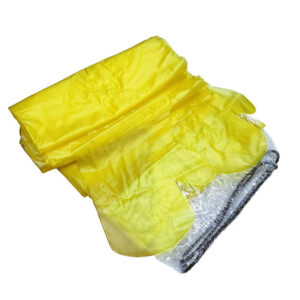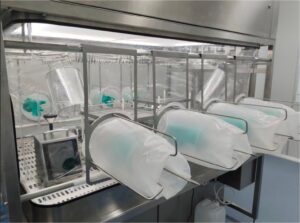Temiz oda ortamları, geleneksel HVAC sistemlerinin çok ötesine geçen hassas hava filtrasyonu gerektirir. İster bir farmasötik üretim tesisi, ister yarı iletken temiz oda veya biyoteknoloji laboratuvarı yönetiyor olun hava fi̇ltresi̇ temelleri̇ mevzuata uygunluğun ve operasyonel verimliliğin sürdürülmesi için kritik hale gelmektedir. Modern temiz oda filtrasyon sistemlerinin karmaşıklığı, teknik özellikler, enerji maliyetleri ve sıkı kontaminasyon kontrol gereklilikleri arasında gezinmek zorunda olan tesis yöneticilerini çoğu zaman bunaltmaktadır.
Riskler daha yüksek olamazdı. Farmasötik bir temiz odadaki tek bir filtrasyon hatası, milyonlarca dolara mal olan ürün geri çağırmalarına neden olabilirken, yarı iletken üretiminde yetersiz partikül kontrolü, karlılığı doğrudan etkileyen verim kayıplarına yol açmaktadır. Son endüstri verileri, temiz oda kontaminasyon olaylarının 73%'sinin yetersiz hava filtreleme tasarımı veya bakım uygulamalarına dayandığını göstermektedir.
Bu kapsamlı kılavuz, temiz oda hava filtrasyonunda uzmanlaşmak için ihtiyaç duyduğunuz teknik bilgileri ve pratik stratejileri sunar. HEPA filtre seçim ilkelerinden gelişmiş filtreleme teknolojilerine kadar, önde gelen tesislerin operasyonel maliyetleri optimize ederken tutarlı kontaminasyon kontrolü elde etmek için kullandığı kanıtlanmış yaklaşımları keşfedeceğiz. YOUTH Temiz Teknoloji bu kritik kararları vermenize yardımcı olmak için onlarca yıllık temiz oda filtrasyon uzmanlığını sunar.
Hava Filtresi Temelleri Nelerdir ve Temiz Odalarda Neden Önemlidir?
Hava filtresi temelleri, kontrollü ortamlarda partikül giderme verimliliğini, hava akışı dinamiklerini ve kontaminasyon kontrolünü yöneten temel ilkeleri kapsar. Standart bina filtrasyonundan farklı olarak, temiz oda hava filtresi temeller partikül boyutu dağılımı, filtre ortamı özellikleri ve katı temizlik sınıflandırmaları arasındaki ilişkinin anlaşılmasını gerektirir.
Etkili temiz oda filtrasyonunun temeli üç ana mekanizmaya dayanır: çarpma, durdurma ve difüzyon. 0,5 mikrondan büyük partiküller tipik olarak filtre fiberleriyle çarpıştıklarında çarpma ile karşılaşırken, daha küçük partiküller fiber yüzeyler tarafından yakalanana kadar hava akım hatlarını takip eder. Mikron altı partiküller 0,1 mikronun altında Brown hareketi sergileyerek difüzyona dayalı yakalamaya yol açar.
Modern temiz oda uygulamaları, sadece yirmi yıl önce imkansız olduğu düşünülen filtrasyon verimliliği seviyeleri talep etmektedir. Günümüzün yüksek verimli sistemleri, 0,3 mikron partiküller için rutin olarak 99,999% partikül giderimi sağlarken, bazı özel uygulamalar daha da yüksek performans standartları gerektirmektedir.
| Filtre Tipi | Verimlilik @ 0,3μm | Tipik Uygulamalar | Basınç Düşüşü (Pa) |
|---|---|---|---|
| HEPA H13 | 99.95% | İlaç, Gıda | 150-250 |
| HEPA H14 | 99.995% | Yarı İletken, Tıbbi Cihaz | 200-300 |
| ULPA U15 | 99.9995% | Gelişmiş Elektronik | 250-350 |
Yüksek Verimli Hava Filtreleri Temiz Oda Ortamlarında Nasıl İşlev Görür?
HEPA Filtre Mekanizmaları ve Performans Standartları
HEPA filtreler, sürekli hava akışı altında yapısal bütünlüğü korurken yüzey alanını en üst düzeye çıkaran kıvrımlı ortam yapısını kullanan temiz oda filtrasyon sistemlerinin temel taşını temsil eder. Temel tasarım, 0,5 ila 2,0 mikron arasında değişen elyaf çaplarına sahip mikrofiber cam veya sentetik ortam içerir ve kirletici partikülleri etkili bir şekilde yakalayan dolambaçlı bir yol oluşturur.
HEPA filtre temelleri üç yakalama mekanizmasının da en az etkili şekilde çalıştığı, tipik olarak 0,1 ila 0,2 mikron civarında meydana gelen en nüfuz edici partikül boyutuna (MPPS) odaklanır. Mühendisler HEPA sistemlerini özellikle bu zorlu partikül boyutu aralığında maksimum verim elde edecek şekilde tasarlar ve tüm spektrumda üstün performans sağlar.
Farmasötik müşterilerle çalışma deneyimimize göre, doğru HEPA seçimi, verimlilik gereksinimleri ile enerji tüketiminin dengelenmesini gerektirir. Önde gelen bir biyolojik ilaç üreticisi, ISO 7 sınıflandırma standartlarını korurken, kritik olmayan destek alanlarında aşırı spesifikasyonlu H14 filtrelerden optimum şekilde seçilmiş H13 ünitelerine geçiş yaptığında yıllık enerji maliyetlerini 18% azalttı.
Ultra Temiz Uygulamalar için ULPA Filtreler
Ultra Düşük Nüfuzlu Hava (ULPA) filtreleri, 0,12 mikron partiküller için 99,999%'yi aşan verimlilikler elde ederek performans özelliklerini geleneksel HEPA standartlarının ötesine taşır. Bu gelişmiş filtreleme sistemleri, tek haneli partikül sayılarının bile verim oranlarını etkileyebildiği yarı iletken üretim tesislerinde vazgeçilmez hale gelmektedir.
ULPA filtreler için gereken üretim hassasiyeti, elektrostatik şarj işlemleri ve dikkatle kontrol edilen plise prosedürleri dahil olmak üzere özel üretim teknikleri gerektirir. Nanofiber teknolojisindeki son gelişmeler, üstün partikül yakalama performansını korurken 40% daha düşük basınç düşüşlerine sahip ULPA filtrelerini mümkün kılmıştır.
Bununla birlikte, ULPA uygulaması dikkatli bir sistem tasarımı değerlendirmesi gerektirir. ULPA filtrelerle ilişkili daha yüksek basınç düşüşleri, eşdeğer HEPA kurulumlarına kıyasla fan enerji tüketimini 25-35% artırabilir, bu da enerji verimliliği analizini uzun vadeli operasyonel planlama için çok önemli hale getirir.
Temiz Oda Tasarımında Temel Hava Filtreleme İlkeleri Nelerdir?
Partikül Boyutu Dağılımı ve Yakalama Verimliliği
Partikül boyutu dağılım modellerinin anlaşılması, etkili parçacık boyutu dağılımının temelini oluşturur. temi̇z oda fi̇ltrasyon si̇stemi̇ temelleri̇. Gerçek dünyadaki kirlenme nadiren teorik modelleri takip eder; gerçek partikül dağılımları proses faaliyetlerine, personel hareketlerine ve dış çevre koşullarına bağlı olarak önemli ölçüde değişir.
Uluslararası Temiz Oda Bilimleri Enstitüsü tarafından yürütülen araştırma, farmasötik temiz odaların 85%'sinin, 0,3 mikron ve 1,2 mikron civarında meydana gelen tepe noktaları ile iki modlu partikül dağılımları yaşadığını göstermektedir. Bu dağılım modeli, filtre seçim stratejilerini ve sistem tasarım parametrelerini doğrudan etkilemektedir.
"Yüzlerce temiz oda kurulumunu analiz ederek edindiğimiz temel içgörü, partikül zorluğunun operasyonel döngüler boyunca önemli ölçüde değiştiğidir. Yalnızca sabit durum koşulları için tasarlanan sistemler, kritik üretim aşamalarında genellikle düşük performans gösterir." - Dr. Sarah Chen, Kontaminasyon Kontrol Araştırmaları Direktörü
Etkili filtrasyon tasarımı, güvenlik faktörlerini dahil ederek ve değişen zorluk seviyelerinde verimliliği koruyabilen filtreler seçerek dinamik partikül yükleme koşullarını hesaba katar. Bu yaklaşım, partikül üretiminin önemli ölçüde arttığı yüksek aktiviteli dönemlerde bile tutarlı performans sağlar.
Hava Akışı Kalıpları ve Filtre Yerleştirme Stratejisi
Temiz oda HVAC sistemleri içinde stratejik filtre yerleşimi, besleme havası, dönüş havası ve proses ekipmanı havalandırması arasındaki karmaşık hava akışı etkileşimlerini anlamayı gerektirir. Temel prensip hava fi̇ltreleme prensi̇pleri̇ temi̇z oda tasarım, kirleticileri kritik çalışma alanlarından uzaklaştıran laminer akış modelleri oluşturmaya odaklanır.
Tavana monte edilen muhafaza ünitelerine takılan terminal HEPA filtreler son filtreleme aşamasını sağlar, ancak ön filtreleme stratejileri genel sistem performansını ve filtre ömrünü önemli ölçüde etkiler. İyi tasarlanmış üç aşamalı bir filtreleme yaklaşımı tipik olarak şunları içerir:
- Ön filtreler (30-35% verimlilik) büyük partikülleri giderir ve aşağı akış filtre ömrünü uzatır
- Orta ölçekli kirleticileri işleyen ara filtreler (85-95% verimlilik)
- Ultra yüksek verimli partikül giderimi sağlayan son HEPA/ULPA filtreler
Büyük bir yarı iletken tesisinde yapılan vaka çalışması analizi, optimize edilmiş ön filtreleme tasarımının HEPA filtre hizmet ömrünü 18 aydan 32 aya uzattığını, yıllık filtreleme maliyetlerini $147.000 oranında düşürdüğünü ve tutarlı ISO 4 temizlik seviyelerini koruduğunu ortaya koymuştur.
| Filtrasyon Aşaması | Partikül Boyut Aralığı | Birincil İşlev | Tipik Hizmet Ömrü |
|---|---|---|---|
| Ön filtreleme | >10 mikron | Kaba partikül giderimi | 3-6 ay |
| Orta seviye | 1-10 mikron | Orta parçacık yakalama | 6-12 ay |
| Son HEPA | 0,1-1 mikron | Ultra ince filtreleme | 12-36 ay |
Uygulamanız için Doğru Yüksek Verimli Filtre Nasıl Seçilir?
ISO Sınıflandırma Gereklilikleri ve Filtre Seçimi
ISO 14644 temizlik sınıflandırmaları, minimum filtrasyon verimliliği gereksinimlerini doğrudan belirleyen belirli partikül sayısı limitlerini belirler. ISO sınıfları ve filtre performansı arasındaki ilişkinin anlaşılması, mevzuata uygunluğu sağlarken aşırı spesifikasyondan kaçınan bilinçli seçim kararları alınmasını sağlar.
ISO 5 temiz odalar (Sınıf 100) için, minimum H13 verimliliğine sahip terminal HEPA filtreler tipik olarak çoğu uygulama için yeterli partikül kontrolü sağlar. Bununla birlikte, önemli mikron altı kontaminasyon üreten prosesler, partikül sayılarını belirtilen sınırların altında tutmak için H14 veya ULPA filtreleri gerektirebilir.
İlaç endüstrisi, biyolojik kontaminasyon kontrolünün genellikle ISO sınıflandırmalarının önerdiğinden daha sıkı filtreleme gerektirdiği benzersiz zorluklar sunar. FDA uyarı mektuplarının yakın zamanda yapılan bir analizi, çevresel izleme ile ilgili ihlallerin 34%'sinin teknik olarak uyumlu ancak pratik olarak yetersiz filtreleme sistemleri kullanan tesisleri içerdiğini ortaya koymuştur.
Biyoteknoloji müşterileriyle olan deneyimlerimiz şunu göstermektedir yüksek veri̇mli̇li̇kte fi̇ltre si̇stemleri̇ Minimum gerekliliklerin üzerinde 20-30% performans marjları ile tasarlanmış olması, ekipman bakımı ve beklenmedik kirlenme olayları sırasında operasyonel esneklik sağlar.
Enerji Verimliliği ve Filtrasyon Performansı Dengesi
Filtrasyon performansını enerji tüketimiyle dengelemek, filtre değiştirme sıklıkları, fan güç tüketimi ve operasyonel kesinti giderleri dahil olmak üzere yaşam döngüsü maliyetlerinin sofistike analizini gerektirir. Gelişmiş medya tasarımlarına sahip modern yüksek verimli filtreler, geleneksel alternatiflere kıyasla basınç düşüşlerini 15-25% azaltırken üstün partikül yakalama sağlayabilir.
Pileli medya teknolojisindeki son yenilikler, daha yüksek toz tutma kapasitesi ve daha uzun servis aralıkları ile sonuçlanan artırılmış pil yoğunluğuna ve optimize edilmiş elyaf yönüne sahip filtreler üretmiştir. Bu gelişmeler doğrudan bakım maliyetlerinin azalması ve sistem güvenilirliğinin artması anlamına gelmektedir.
Bununla birlikte, enerji optimizasyon stratejileri temiz odaya özgü operasyonel gereksinimleri dikkate almalıdır. Daha düşük basınç düşüşü fan enerji tüketimini azaltırken, yetersiz hava değişim oranları kontaminasyon kontrol etkinliğini tehlikeye atabilir ve potansiyel olarak enerji tasarrufunu çok aşan maliyetli ürün kayıplarına yol açabilir.
Temiz Oda Hava Filtrasyon Sistemlerinde Sık Karşılaşılan Zorluklar Nelerdir?
Filtre Yükleme ve Basınç Düşümü Yönetimi
Aşamalı filtre yüklemesi, temiz oda filtrasyon yönetimindeki en önemli operasyonel zorluklardan birini temsil eder. Partiküller filtre ortamında biriktikçe, basınç düşüşleri katlanarak artar ve HVAC sistemlerini daha fazla çalışmaya zorlarken, temiz oda genelinde hava akışı homojenliğini potansiyel olarak tehlikeye atar.
Sektör verileri, filtre hizmet ömrünün ilk 60% döneminde filtre basınç düşüşünün tipik olarak iki katına çıktığını, ardından toz yüklemesi kapasite sınırlarına yaklaştıkça hızla arttığını göstermektedir. Bu doğrusal olmayan ilişki bakım planlamasını zorlaştırır ve beklenmedik sistem performansı düşüşlerine yol açabilir.
Diferansiyel basınç izleme ve partikül sayımı kullanan kestirimci bakım stratejileri, filtre doygunluk koşulları hakkında erken uyarı sağlar. Otomatik izleme sistemleri uygulayan bir ilaç tesisi, acil durum filtre değişimlerini 67% azaltırken ortalama filtre hizmet ömrünü 23% uzatmıştır.
Otomatik izleme değerli operasyonel bilgiler sağlarken, sensör ağlarına ve veri yönetim sistemlerine yapılan ilk yatırım önemli miktarda sermaye harcaması gerektirebilir. Tesisler, izleme maliyetlerini optimize edilmiş filtre değiştirme planlamasından elde edilecek potansiyel tasarruflara karşı değerlendirmelidir.
Bakım Planlaması ve Performans İzleme
Etkili bakım protokolleri geliştirmek, filtre hizmet ömrü optimizasyonu ile kirlenme kontrolü güvencesini dengelemeyi gerektirir. Geleneksel zamana dayalı değiştirme programları genellikle işletme maliyetlerini artıran erken filtre değişimleriyle sonuçlanırken, duruma dayalı yaklaşımlar sofistike izleme yetenekleri gerektirir.
Temiz oda hava filtresi temelleri filtre performansı düşüşünün nadiren tüm ünitelerde aynı şekilde gerçekleştiğini anlamayı içerir. Hava akışı dağılımındaki, partikül yükleme modellerindeki ve yerel çevre koşullarındaki farklılıklar, aynı filtre kurulumları için bile farklı hizmet gereksinimleri yaratır.
"Başarılı bir temiz oda filtrasyon yönetiminin, her filtre grubunu belirli performans özelliklerine sahip benzersiz bir sistem olarak ele almayı gerektirdiğini öğrendik. Genel bakım yaklaşımları, müşterilerimizin talep ettiği operasyonel güvenilirliği sağlayamıyor." - Mark Rodriguez, Kıdemli Uygulama Mühendisi
Gelişmiş tesisler, yerel kirlilik kaynaklarını ve proses faaliyetlerini dikkate alan bölgeye özel bakım stratejileri uygular. Bu hedefe yönelik yaklaşım, tesis genelinde katı temizlik gerekliliklerini korurken optimum filtre kullanımını sağlar.
Gelişmiş Filtre Teknolojileri Temiz Oda Performansını Nasıl Artırır?
Elektrostatik Filtreler ve Yüklü Ortamlar
Elektrostatik filtrasyon teknolojileri, geleneksel mekanik filtrasyonu tamamlayan elektrik yükü mekanizmaları aracılığıyla partikül yakalama verimliliğini artırır. Yüklü fiber medya, özellikle mekanik mekanizmaların en az etkili şekilde çalıştığı 0,1 ila 0,3 mikron aralığındaki partiküller için mikron altı partikül yakalamayı önemli ölçüde iyileştiren elektrostatik çekim kuvvetleri oluşturur.
Elektrospinning teknolojisindeki son gelişmeler, filtre hizmet ömrü boyunca elektrostatik özelliklerini koruyan kalıcı yüklü liflere sahip nanofiber filtre ortamı üretmiştir. Bu gelişmiş malzemeler, geleneksel cam elyaf ortamlara kıyasla 30-40% daha düşük basınç düşüşleri ile HEPA düzeyinde verimlilikler elde etmektedir.
Ancak elektrostatik filtre performansı, nemin yük tutma özelliğini azalttığı yüksek nemli ortamlarda düşebilir. Önemli miktarda buhar veya solvent buharı içeren temiz oda uygulamaları, elektrostatik filtre uygunluğunun dikkatli bir şekilde değerlendirilmesini gerektirir ve hibrit filtreleme yaklaşımlarından yararlanabilir.
Hibrit Filtrasyon Sistemleri
Hibrit filtrasyon sistemleri, farklı partikül boyutu aralıklarında ve kirlilik zorluklarında performansı optimize etmek için birden fazla yakalama mekanizmasını birleştirir. Bu gelişmiş sistemler tipik olarak kapsamlı kirletici kontrolü için mekanik filtrasyonu elektrostatik güçlendirme, aktif karbon adsorpsiyonu veya fotokatalitik oksidasyon ile entegre eder.
Yarı iletken endüstrisi, moleküler kontaminasyon kontrolünün geleneksel partikül gideriminin yanı sıra özel gaz fazı filtrasyonu gerektirdiği hibrit filtrasyon uygulamalarına öncülük etmiştir. Gelişmiş temiz oda filtrasyon sistemleri moleküler filtrelerin dahil edilmesi, kritik proses gazları için milyarda parça kontaminasyon kontrolü sağlayabilir.
Entegrasyon karmaşıklığı, hibrit filtrasyon sistemlerinin birincil sınırlamasını temsil eder. Çoklu filtreleme teknolojileri koordineli bakım programları, özel izleme ekipmanları ve yüksek eğitimli teknik personel gerektirir. İlk sistem maliyetleri tipik olarak geleneksel filtrelemeyi 150-200% kadar aşar, ancak operasyonel faydalar genellikle kritik uygulamalar için yatırımı haklı çıkarır.
| Teknoloji Türü | Birincil Avantaj | Tipik Uygulamalar | Uygulama Karmaşıklığı |
|---|---|---|---|
| Elektrostatik Güçlendirme | Geliştirilmiş mikron altı yakalama | Elektronik, Havacılık ve Uzay | Orta |
| Moleküler Filtrasyon | Gaz fazı kontaminasyon kontrolü | Yarı İletken | Yüksek |
| Fotokatalitik Sistemler | Biyolojik inaktivasyon | İlaç, Sağlık Hizmetleri | Yüksek |
Sonuç
Hava filtresi temellerini anlamak; performans, verimlilik ve maliyet etkinliği arasında denge kuran başarılı temiz oda filtreleme sistemlerinin tasarlanması ve işletilmesi için temel oluşturur. Temel HEPA filtre seçim ilkelerinden gelişmiş hibrit teknolojilere kadar anahtar, operasyonel esnekliği korurken filtreleme yeteneklerini belirli uygulama gereksinimleriyle eşleştirmede yatmaktadır.
Temiz oda filtrasyon ortamı, gelişmiş malzemeler, öngörücü bakım teknolojileri ve kontaminasyon kontrol performansını artırırken işletme maliyetlerini azaltan enerji tasarruflu tasarımlarla gelişmeye devam ediyor. Kapsamlı filtreleme stratejileri uygulayan tesisler, toplam sahip olma maliyetlerinde 15-25%'lik düşüşlerin yanı sıra mevzuata uyumluluk oranlarının da arttığını bildirmektedir.
İleriye dönük olarak, başarılı temiz oda operasyonları, optimize edilmiş filtre seçimi, öngörücü bakım ve gelişmiş izleme sistemlerini birleştiren entegre yaklaşımlara giderek daha fazla bağlı olacaktır. Kontaminasyon kontrol gereklilikleri daha sıkı hale geldikçe ve enerji maliyetleri artmaya devam ettikçe, bu konularda uzmanlaşan tesisler yüksek veri̇mli̇li̇k fi̇ltre temelleri̇ üstün operasyonel güvenilirlik ve maliyet kontrolü yoluyla rekabet avantajlarını koruyacaktır.
Mevcut filtreleme yaklaşımınızın bu gelişen zorlukları nasıl ele aldığını düşünün. Temiz oda yatırımınızdan maksimum değer elde etmek için gelişmiş teknolojilerden ve optimizasyon stratejilerinden yararlanıyor musunuz? Yeni nesil temi̇z oda fi̇ltrasyon çözümleri̇ kapsamlı kontaminasyon kontrol stratejilerini benimsemeye hazır tesisler için benzeri görülmemiş fırsatlar sunmaktadır.
Sıkça Sorulan Sorular
Q: Temiz oda filtrasyonunda yüksek verimli hava filtrelerinin temel prensipleri nelerdir?
C: HEPA ve ULPA filtreler gibi yüksek verimli hava filtreleri, havadaki partikülleri yoğun bir mikro gözenekli lif ağı aracılığıyla yakalayarak çalışır. HEPA filtreler 0,3 mikron veya daha büyük partiküllerin en az 99,97%'sini giderirken ULPA filtreler 99,999% verimlilikle daha da küçük partikülleri yakalar. Bu filtreler temiz oda ortamlarında toz, mikrop ve diğer kirleticileri gidererek katı hava kalitesini korumak için gereklidir. Etkinlikleri, ön filtrelerin önce daha büyük partikülleri yakaladığı, yüksek verimli filtreleri koruyan ve kullanım ömürlerini uzatan çok aşamalı filtreleme sistemlerine dayanır.
Q: Temiz oda uygulamalarında HEPA filtrenin ULPA filtreden farkı nedir?
C: HEPA (Yüksek Verimli Partikül Hava) ve ULPA (Ultra Düşük Penetrasyonlu Hava) filtreleri öncelikle partikül yakalama verimliliği ve maliyet açısından farklılık gösterir. HEPA filtreler 0,3 mikronda 99,97% partikül giderir, bu da onları çoğu temiz oda ortamı için uygun hale getirir. ULPA filtreler, 99,999% verimlilikle 0,1 mikrona kadar partikülleri yakalar, üstün filtreleme sunar, ancak daha yüksek maliyet ve enerji kullanımı sağlar. HEPA filtreler daha uzun filtre ömrüne ve daha düşük işletme maliyetlerine sahip olma eğilimindedir, bu da onları ultra ince partikül filtrasyonu gerekmedikçe popüler bir seçim haline getirir.
Q: Temiz oda hava filtrasyon sistemlerinde ön filtreleme neden önemlidir?
C: Ön filtreleme çok önemlidir çünkü hava HEPA veya ULPA gibi yüksek verimli filtrelere ulaşmadan önce daha büyük partikülleri yakalar. Bu adım, bu kritik filtrelerin tıkanmasını ve hasar görmesini azaltarak hizmet ömürlerini uzatır ve hava akışı verimliliğini korur. Ön filtreler, büyük kirleticileri erken yakalayarak bakım maliyetlerini düşürmeye, sistemin arıza süresini azaltmaya ve enerji tüketimini optimize etmeye yardımcı olur, bu da genel olarak temiz odanın hava kalitesini ve operasyonel performansını artırır.
Q: Temiz odalarda yüksek verimli hava filtrelerinin yaygın uygulamaları nelerdir?
C: Yüksek verimli hava filtreleri, ilaç, yarı iletken üretimi, biyoteknoloji ve sağlık hizmetleri gibi kontrollü ortamlar gerektiren endüstrilerde kullanılır. Toz, bakteri ve kimyasal yan ürünler gibi zararlı partikülleri filtreleyerek kontaminasyon kontrolünü sağlarlar. Filtreler, temiz odalardaki hassas süreçleri, ürünleri ve personeli korumak için uyumlu hava kalitesi seviyelerinin korunmasına yardımcı olur.
Q: Yüksek verimli hava filtreleri temiz oda işletme maliyetlerini ve sürdürülebilirliği nasıl etkiler?
C: Yüksek verimli filtreler hava saflığını korumak için gerekli olsa da, performansları ve uzun ömürlülükleri işletme maliyetlerini doğrudan etkiler. Etkili ön filtreleme de dahil olmak üzere uygun filtreleme tasarımı, filtre değiştirme sıklığını ve enerji kullanımını azaltır. Sürdürülebilir filtre teknolojileri dayanıklılığı ve verimliliği optimize ederek hem bakım masraflarını hem de çevresel etkiyi azaltır. Böylece kaliteli filtrelere ve bakım stratejilerine yatırım yapmak, temiz oda hava kalitesini uygun maliyetli ve çevre dostu operasyonlarla dengeler.
Q: Bir temiz oda için yüksek verimli hava filtresi seçerken hangi faktörler göz önünde bulundurulmalıdır?
C: Temel faktörler arasında gerekli partikül boyutu yakalama verimliliği, temiz oda sınıflandırma standartları, filtre ömrü, enerji tüketimi ve maliyet yer alır. HEPA filtreler, 0,3 mikron partikül gideriminin yeterli olduğu çoğu temiz odaya uygunken, ultra temiz ortamlar için ULPA filtreler gereklidir. Ek olarak, optimum performans ve bakım sağlamak için filtre formatı, değiştirme kolaylığı ve mevcut HVAC sistemleriyle uyumluluk değerlendirilmelidir.
Dış Kaynaklar
- Temiz Oda Partikül Filtrasyonunun Temelleri - Lighthouse Worldwide Solutions - Bu makale, temiz oda ortamlarında HEPA ve ULPA filtrelerinin rolü ve sınırlamaları da dahil olmak üzere temiz oda partikül filtrasyon temellerine kısa bir genel bakış sunmaktadır.
- Temiz Oda Hava Filtrasyonu: Filtre Türleri ve Ne İşe Yaradıkları - Allied Cleanrooms - Yüksek verimli partikül hava (HEPA) filtrelerine, standartlarına ve uygulama temellerine odaklanarak temiz odalarda kullanılan hava filtresi türlerini açıklar.
- HEPA ve ULPA Filtreler için Nihai Kılavuz - Terra Universal - HEPA ve ULPA filtre tanımlarına, verimlilik derecelerine, avantajlarına ve temiz oda filtreleme gereksinimlerine derinlemesine bir bakış sunar.
- HEPA Filtreler Hakkında Bilmeniz Gereken Neredeyse Her Şey - TRC Healthcare - HEPA filtre tasarımı, işlevi ve kontrollü ortamlarda havayla taşınan kirleticilerin azaltılmasındaki kritik rolü hakkında kapsamlı bir genel bakış.
- Sürdürülebilir HVAC Filtrasyonu ile Temiz Oda Hava Kalitesini Artırma - Camfil USA - Çok aşamalı HVAC filtreleme stratejileri ve ön filtreler, HEPA ve ULPA filtrelerin faydaları dahil olmak üzere temiz odalar için sürdürülebilir yüksek verimli hava filtrelemesini tartışır.
- HEPA & ULPA Filtre Temelleri ve Testleri - Filtre Teknolojisi - Yüksek verimli hava filtrasyonunun teknik temellerini, filtre yapısını, verimlilik standartlarını ve temiz oda test yöntemlerini ayrıntılarıyla açıklar.
İlgili İçerikler:
- HEPA vs ULPA Filtreler: Doğru Seçeneği Seçmek
- Laminer Akış Üniteleri için ULPA ve HEPA Filtreler
- HEPA Filtre Verimliliği: Hava Arıtmayı En Üst Düzeye Çıkarma
- Temiz Oda Hava Filtresi Tipleri | Ön Filtre - ULPA Karşılaştırması
- HEPA Filtre Sistemleri | Klima Santrali Ekipmanları Teknik Özellikleri
- Laminer Üniteler için ULPA vs HEPA 2025
- Temiz Oda Hava Filtreleri Nelerdir | HEPA vs ULPA Temelleri
- ULPA vs HEPA Muhafaza Kutuları: Temiz Oda Performans Verileri
- HEPA vs ULPA Muhafaza Kutuları: Doğru Filtrasyonu Seçmek




























